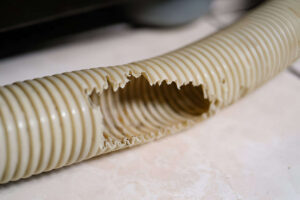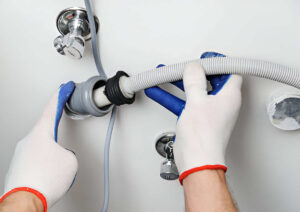Washing Machine Drain Plumbing: DIY Setup & Tips
Modern homes can’t live without a washing machine, but even the best washer won’t work well without a sound plumbing system for the drain. It can be hard to install or keep the plumbing drain pipe for a washing machine, but if you know what you’re doing, you can make sure the machine works safely and without leaks. From the different kinds of drains to how to put something together yourself, this guide has it all. It even has tips from pros.
Why Proper Washing Machine Drain Plumbing Matters
A lot of water is wasted from your washing machine during each run. If you don’t install a plumbing outlet duct for a washing machine, the following things could happen:
- Damage to the walls and floors from water
- Problems with backflow or not enough drainage
- Microorganisms and mould could grow in large numbers.
- Less efficient use and shorter life of machines
It is safe to get rid of water through a well-thought-out sewage system. This also makes the pipes less stressed and stops leaks. For more tips on water lines and appliances in the home, click here. Check out our guide on DIY Plumbing Tips for Kitchen Sink & Bathroom Diagram.

Essential Components of Washing Machine Drain Plumbing
1. Drain Hose
The Hose is what links your washing machine to the plumbing in your house.
- Standard Size: They typically have a diameter of 1 to 1.5 inches.
- Installation Tip: A high loop or air gap prevents filthy water from syphoning back into the machine.
2. Standpipe
This vertical pipe serves as the outlet for the drain hose to expel wastewater.
- Standard Height: 30 to 36 inches above the floor.
- Diameter: A minimum of 2 inches is required for adequate flow.
3. P-Trap
To prevent sewage gases from entering your house. The pipe in the shape of a U may be found sitting beneath the standpipe. This device aims to collect water.
4. Ventilation
The vent pipe avoids airlocks and smooths water flow.
Tip: Always check your local building codes, as some places have rules about water systems that drain washing machines.
DIY Setup for Washing Machine Drain Plumbing
Tools & Materials You’ll Need
- PVC plugs and lines
- Cutting tools and sandpaper
- Paint and glue for PVC
- Teflon tape and a pipe wrench
- Level and tape measure
Plan Your Drain Route
Find the place where your washer is. Get in touch with the nearest drain link or set up a new standpipe system for this purpose.
Install the Standpipe
- To make sure the straight PVC pipe is at least 2 inches wide, measure and cut it.
- For a watertight closure, please attach it to the P-trap below using PVC adhesive.
- Ensure that the height of the standpipe is consistent with the code requirements.
Add the P-Trap
- Place the snare directly beneath the standpipe.
- Please attach it to an existing drainage line or install a new horizontal line to your primary outflow.
Connect Ventilation
Connect the outflow pipe to ensure the water drains well. Installing an air admittance valve (AAV) could be a good idea for older homes that lack sufficient airflow.
Attach the Washing Machine Hose
Make sure the washer line is connected to the standpipe firmly. Attach a clip or guide to the Hose so that it doesn’t come off during shots.

Common Problems and Fixes
1. Slow Drainage or Overflow
- Cause: incorrect hose positioning or a clogged standpipe.
- Solution: Clean the pipe, check the hose height, and check for clogs.
2. Unpleasant Odours
- Cause: P-trap is dry or broken.
- Solution: Check for leaks, reseal the links and pour water into the trap every so often.
3. Leaking Connections
- Cause: Fixings or lines that are broken.
- Solution: To make links stronger and to fix any broken parts, use Teflon tape.
Safety & Maintenance Tips
- Avoid Overloading: Drainage surges can be caused by heavy loads.
- Use a Drain Filter: keeps lint and dirt from getting into the pipes.
- Inspect Annually: Check the joints, standpipes and lines for damage or leaks.
- Upgrade Old Systems: If your home’s pipes are old, consider replacing them with new PVC pipes.
Professional vs. DIY Plumbing
DIY Advantages
- Savings on costs
- Get valuable tips on how to fix up your house.
- Get valuable tips on how to fix up your house.
When to Call a Professional
- Changing the paths of complex pipes
- A lot of spills or leaks
- Not being able to cut or take out pipes
Environmental Considerations
Do you get it? One load of laundry uses around 19 gallons of water, according to Energy Star. Setting up the drain lines for the washer properly will ensure that the water drains properly and the area stays clean. You can water your plants again with the same water if you connect a gadget that collects graywater.
Conclusion
The right drain pipe must be put in place and kept up so that the washer works well and water damage is minimised. If you do it right, your washing machine will work safely and efficiently whether you do it yourself or hire a pro.
FAQs: Washing Machine Drain Plumbing
What size drain pipe should a washing machine have?
The average width of a washing machine drain pipe is 2 inches, so that it can handle a lot of water flow and prevent clogs.
What is the appropriate height for the washing machine drain pipe?
The optimal height ranges from 30 to 36 inches above the floor to effectively prevent backflow and guarantee proper drainage.
Can a washing machine drain be connected directly to the sewer line?
To make sure that sewer fumes don’t get into your home, you do need to include a P-trap and enough air.
Can I prevent my washing machine drain from clogging?
Use a lint screen, clean the pipe, and don’t load the machine with heavy, lint-filled garments.
Do I need to hire a plumber to set up the sink for my washing machine?
If you’re unsure about plumbing, how to install a drain pipe for a washing machine, or the rules in your area, you should hire a plumber.
References